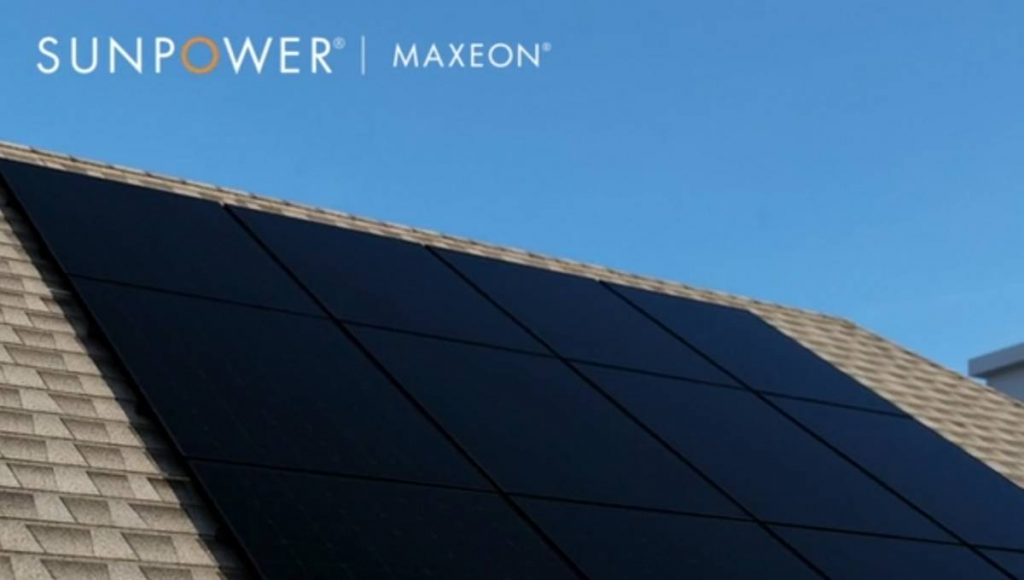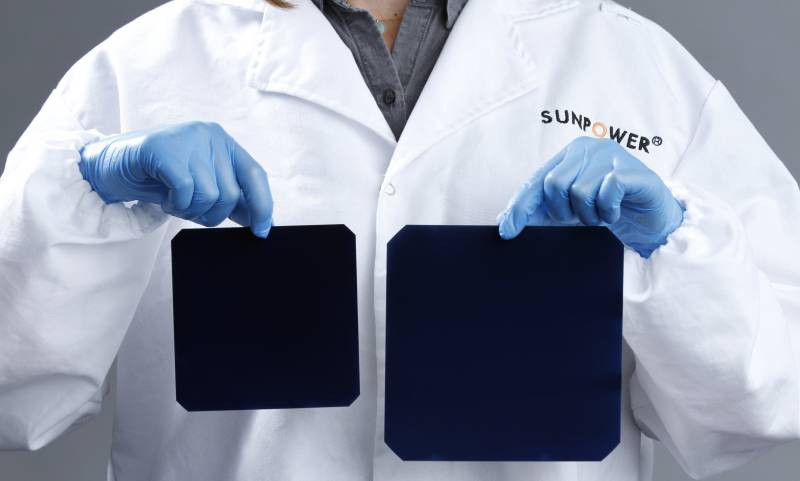The first 400 watt solar panel for the Australian residential market is now available from SunPower – the Maxeon 3.
Featuring SunPower’s Maxeon cells, the SPR-MAX3-400 has a conversion efficiency of 22.6%, which is assumed to be under standard test conditions (ambient air temperature of 25C, solar irradiance of 1000 Watts per square meter). This is significantly higher than good quality entry-level panels, which generally range between 15-17%.
The Maxeon 3 has temperature coefficient of −0.29% /°C, which means its output will drop by around 0.29% for every degree the panel gets above 25ºC (learn more – solar panel specifications – what you need to know).
The 400W solar panel’s dimensions are 1046mm x 1690mm x 40mm and it weighs in at 19kg. The SPR-MAX3-400 could be particularly attractive to those with limited roof space as while the panels are large, watt for watt a Maxeon 3 based system would take up significantly less rooftop real estate compared to systems using one of many other popular panel brands.
One of the features of SunPower’s Maxeon cells is the use of back-contact conductivity – eliminating what the company calls “unsightly” gridlines. While aesthetics may not be a burning issue for many solar buyers, this back-contact arrangement also enables more energy harvesting.
Maxeon cells appear to be pretty tough and flexible beasties, as demonstrated in this video.
“SunPower is introducing the world’s first 400-watt residential solar panels as most in the industry are just crossing the 300-watt threshold for home solar,” said Jeff Waters, CEO of SunPower’s Technologies business unit.
The press release also mentions SunPower’s “industry-leading 25-year Combined Power and Product Warranty” – but just how iron-clad that warranty is in some circumstances has been called into question here on SQ previously.
While I wasn’t able to find pricing on the SPR-MAX3-400, it won’t be for those shopping for a good budget solar power system. As SQ’s Ronald has previously quipped, SunPower offer the best panels that lots of money can buy.
A specification sheet for the SunPower Maxeon 3, which is also available in 390W and 370W capacity can be downloaded here.
415W Panel With Microinverter For U.S. Market
In the USA, SunPower has released its A-Series solar panels, based on the company’s Maxeon Gen 5 cells that it says are 65 percent larger than prior generations.
The A-Series is available in 400W or 415W capacity and feature a factory-integrated microinverter manufactured by Enphase Energy. In June last year, Enphase inked a deal to acquire SunPower’s microinverter business.
SunPower Chairman and CEO Tom Werner is bullish on microinverter technology, stating last August he believed AC solar panels are the future. But his vision of the future is yet to arrive in Australia, with a factory-integrated microinverter on a SunPower solar panel yet to be seen here.
SunPower is one of the old-timers of the PV industry – it has its roots back in the 1970’s and was officially incorporated in 1985. The company says more than 10.3 gigawatts of SunPower solar products have been installed globally to date.
While SunPower may be one of the world’s oldest solar manufacturers, it’s certainly not the biggest. For example, JinkoSolar reportedly shipped more panel capacity in 2018 alone (11.6GW) than SunPower has ever produced.



 RSS - Posts
RSS - Posts



As the maximum PV panels generating capacity for a single phase domestic rooftop photovoltaic system in Australia, appears to be 6.6kW, I expect that the optimum per panel capacity for Australia, would be an integer factor of 6.6kW; for example, 300W (22 panels), 330W (20 panels), 600W (11 panels), 660W (10 panels), or, 1100W (6 panels), to get the optimum output. Also, probably, for a number of panels with an integer result, when divided by two, so eliminating the 600W panel capacity, to allow for symmetric capacities for each of two strings; eg, eastward and westward.
So if you are hell bent on using the latest 400W panels from Sunpower (104 cells) but you also want to stay with micro inverters from Enphase, what do you do? In the US they come as a combo (panel and micro inverter) but in Oz the biggest micro inverter from Enphase is IQ7X only catering for 96 cells even though it looks like it could handle the voltage. Any suggestions?
As the Enphase IQ7+ is a 290 watt microinverter, if it is used with a 400 watt panel it won’t be eligible to receive the STCs that lower the cost of rooftop solar. So I don’t suggest using that combination unless you are loaded and don’t mind the extra cost. The largest panel that can be used with the IQ7+ and still receive STCs is 386 watts.
If you are loaded and want to use them together, I’d suggest contacting Enphase and checking if the combination is acceptable and if they will warrant it.
Let’s start again. Our roof space can fit maximum 16 panels and there are some shading issues. We also wanted to “extend” the day as much as possible so some panels will be North facing, others West facing. That is how we ended up looking at “expensive” Sunpower panels and working with micro inverters. What would be an alternative approach if we wanted to stick with Sunpower panels?
Hi Fredrik
You could install sixteen 400 watt panels with a 5 kilowatt string inverter. If you are concerned about shading you can use optimisers on the panels which will give benefits similar to microinverters. This will allow you to get the STCs that lower the cost of solar as normal. Optimisers only need to be placed one panels that suffer from shade. Here is an infographic comparing optimisers and microinverters:
https://www.solarquotes.com.au/blog/microinverters-vs-dc-optimisers-which-is-best-infographic/
SunPower panels with optimisers (or microinverters) are very effective at coping with shade, although nothing will make a panel perform well when it is shaded.
Thank you Ronald,
How would a solution like that compare to using a smaller Sunpower panel like the X-Series: X22-370 with the IQ7+ if the preference is to stick with micro inverters? Are the two system ending up roughly on par?
I would expect panels of equal wattage to have no significant difference in output between a microinverter or an optimiser. If you have sixteen 370 watt panels with microinverters I would expect the average output to be about 7.5% less than sixteen 400 watt panels with optimizers and a string inverter. If you prefer microinverters the 370 watt panels may be the best option for you but if you want to maximise your total solar generation then 400 watt panels with optimisers where required would be best.
Hi Ronald,
I’ve been looking at getting at getting some of these Sunpower 400w panels due to a limitation on available space. My installer isn’t part of the Sunpower distributor network and has offered LG 400W 72 cell panels as an alternative.
My question is are they comparable in a residential situation? I’ve read articles on hear about 60 cell vs 72 cell in a residential setting and I am not sure. Would a 72 cell LG 400w panel cost the same or would you expect it to be cheaper than a Sunpower 400W panel? Is there anything you would consider sway you either way to the choice of panel? In this instance I’m only looking to have a 2kW array installed with a new inverter so they would be eligible for STC’s.
Hi Tim
LG panels are high quality have the same 25 year product warranty as SunPower and I would expect them to be cheaper. You can compare the panels on our table here:
https://www.solarquotes.com.au/panels/comparison/compare-solar-panels/
There are some issues with 72 cell panels. The main one being their larger size can make them harder to fit on a roof. I cover some of the issues here:
https://www.solarquotes.com.au/blog/72-cell-solar-panels/
Looking it up I see LG panels appear to have clamping zones that are 20cm across, which is better than some panels. The good news is, if the clamps are in the correct zones, its physical strength will be well above that of the average, correctly clamped, panel. Provided your installer does quality work and takes care to use the correct clamping zones there should be no problem.
Are these panels Monocrystaline or the other type?
We wish to go solar, but have been told by the ‘experts’ to make sure the panels are Monocrystaline.
These panels are monocrystalline, but there is no real difference between mono and poly panels. If you want highly efficient panels to get the most out of a limited amount of roof space then mono will be best, but if roof space is not an issue then it is the quality of the individual panels make and brand that matters.
Hi
Ive just purchased at Toyota coaster that I’m wanting to travel and live off grid as much as possible. I’m looking for the strongest and most light weight effective way of doing this. Could anybody help me?
Cheers
SunPower makes flexible SolarPanels that can be purchased at a reasonable price. I assume they are of good quality because they are SunPower, but as I haven’t looked into them, so I couldn’t say.
Hi just would like to know if $16,000 for 20 Maxeon 3 solar panels is to much.